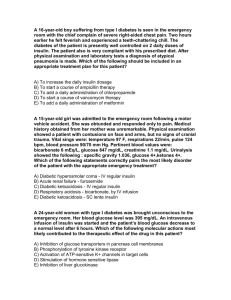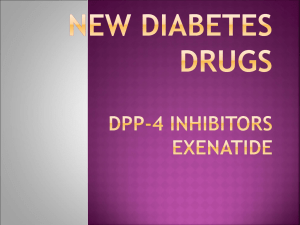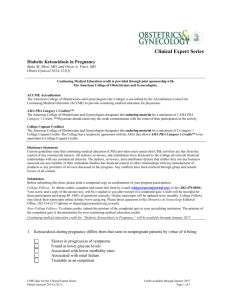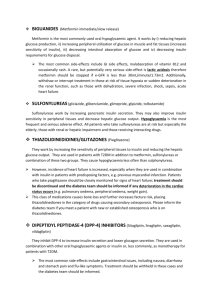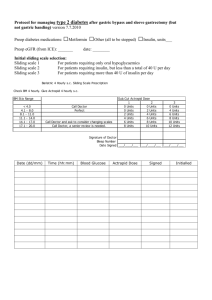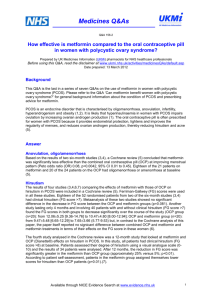solution-nursing-pharmacology
advertisement
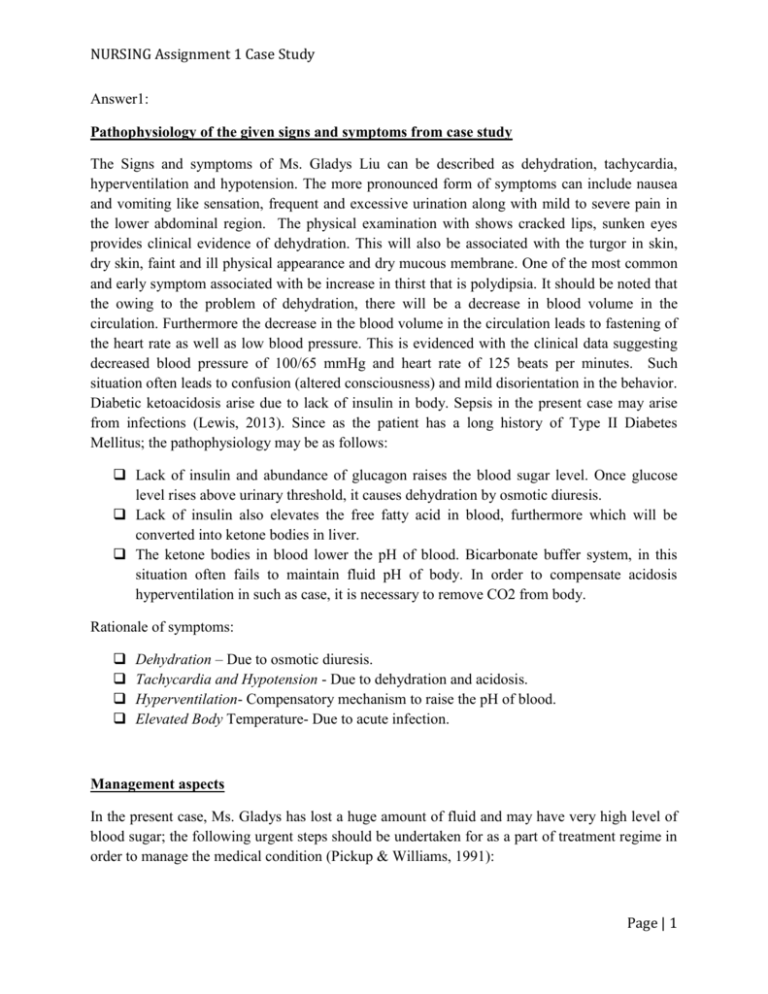
NURSING Assignment 1 Case Study Answer1: Pathophysiology of the given signs and symptoms from case study The Signs and symptoms of Ms. Gladys Liu can be described as dehydration, tachycardia, hyperventilation and hypotension. The more pronounced form of symptoms can include nausea and vomiting like sensation, frequent and excessive urination along with mild to severe pain in the lower abdominal region. The physical examination with shows cracked lips, sunken eyes provides clinical evidence of dehydration. This will also be associated with the turgor in skin, dry skin, faint and ill physical appearance and dry mucous membrane. One of the most common and early symptom associated with be increase in thirst that is polydipsia. It should be noted that the owing to the problem of dehydration, there will be a decrease in blood volume in the circulation. Furthermore the decrease in the blood volume in the circulation leads to fastening of the heart rate as well as low blood pressure. This is evidenced with the clinical data suggesting decreased blood pressure of 100/65 mmHg and heart rate of 125 beats per minutes. Such situation often leads to confusion (altered consciousness) and mild disorientation in the behavior. Diabetic ketoacidosis arise due to lack of insulin in body. Sepsis in the present case may arise from infections (Lewis, 2013). Since as the patient has a long history of Type II Diabetes Mellitus; the pathophysiology may be as follows: Lack of insulin and abundance of glucagon raises the blood sugar level. Once glucose level rises above urinary threshold, it causes dehydration by osmotic diuresis. Lack of insulin also elevates the free fatty acid in blood, furthermore which will be converted into ketone bodies in liver. The ketone bodies in blood lower the pH of blood. Bicarbonate buffer system, in this situation often fails to maintain fluid pH of body. In order to compensate acidosis hyperventilation in such as case, it is necessary to remove CO2 from body. Rationale of symptoms: Dehydration – Due to osmotic diuresis. Tachycardia and Hypotension - Due to dehydration and acidosis. Hyperventilation- Compensatory mechanism to raise the pH of blood. Elevated Body Temperature- Due to acute infection. Management aspects In the present case, Ms. Gladys has lost a huge amount of fluid and may have very high level of blood sugar; the following urgent steps should be undertaken for as a part of treatment regime in order to manage the medical condition (Pickup & Williams, 1991): Page | 1 NURSING Assignment 1 Case Study Fluid replenishment: Rapid infusion of saline approximately 1 liter per day is recommended in order to restore the circulatory volume. Potassium replenishment: It is a general fact that insulin decreases the potassium level in the physiological condition by virtue of redistribution inside the cells. Moreover there will be a huge loss of potassium in the urine because of osmotic diuresis. A regular assessment of body potassium level is needed in this case and the potassium should be administered by intravenous route in case the level of potassium in blood decreases below 5.3 mmol. Liter-1. Insulin: Bolus dose of Insulin after attaining normal potassium levels. In general if the potassium level of the body is higher than 3.3 mmol. Liter-1 a prescribed dose of insulin (0.1 unit per kg of body weight) is recommended for administration. The administration of insulin should be carefully monitored with respect to the blood sugar level. It should be noted that the insulin administration will help in recusing the blood sugar level as well as for suppression of ketone body production. Bicarbonate: The increase of blood pH because of high level of ketone is also necessary to maintain. A prescribed dose of sodium bicarbonate is thus required to compensate (increase) the pH level of acidic blood. Blood pH, Blood glucose, Blood potassium level and heart rate to be monitored at regular interval. Immediate broad spectrum antibiotic treatment. Sepsis with respect to urinary tract infection should be confirmed after test and antibiotics oriented for management in this respect should be thus attempted only after confirmation. Page | 2 NURSING Assignment 1 Case Study Question2: Investigation and test A brief of the necessary investigation and/or test that is required to be ordered for Ms. Gladys are explained in Table 1 (Provan, 2010). The justified normal levels of specific attributes in each of the investigation and/or test have been mentioned as normal level. A brief of the rationale for each of the individual investigation has been provided in the table. Table 1: Relevant investigation and/or test that should be addressed in context of Ms. Gladys. Sl. No. 1 Investigation 2 Blood Ketone < 0.6mmol/L Bodies Measurement Arterial Blood Gas pH 7.34-7.44 Measurement PaO211-13kPa PaCO24.7-6.0kPa Venous Blood PaO2 30-40 mmHg Measurements PaCO2 40-50 mmHg Urine Ketone Bodies 0.5-3.0 mg/dl Measurement Blood β- 0.4-0.5 mmol/L hydroxybutyrate Serum Creatinine/ Urea- 20-40 mg/dL Urea Creatinine- 0.7-1.2 mg/dL Complete Blood Normal Cell counts Count C-reactive Protein Below 1.0 Test milligram per deciliter Culture of blood and NA urine sample 3 4 5 6 7 8 9 10 Normal Level Blood Glucose Level 80-110 mg/dl Rationale To check the level of hyperglycaemia and determine the dose of insulin To determine the mode of administration of anti-hyperglycaemias medication To determine the lungs efficacy in gaseous exchange and buffering capacity of blood To determine the lungs efficacy in gaseous exchange and buffering capacity of blood To justify the associated investigation of Diabetic Ketoacidosis. To determine the level of starvation To determine the renal efficacy To determine infection, if any. To determine infection, if any. To determine UIT or Sepsis, if any. Expected results: According to the American Diabetes Association, there are three stages of Diabetic ketoacidosis, viz. mild, moderate and severe, depending upon the blood pH, bicarbonate level and physical fitness of patient. Some of the general criteria that are expected from the above investigations of Ms. Gladys are; Plasma glucose will be more than 250 mg.dl-1. Page | 3 NURSING Assignment 1 Case Study pH of blood will be in a range of <7.0, 7.0 – 7.24 and 7.25 - 7.3 depending upon the classification system of severe, moderate and mild stages of Diabetic ketoacidosis. Similarly, bicarbonate level of serum will be <10, 10-15 and 15-18 depending upon the classification system of severe, moderate and mild stages of Diabetic ketoacidosis. Urine and/or serum ketone will be positive in test. Mental status or physiological fitness can be attributed to stupor like condition, drowsiness and alert as corresponding to severe, moderate and mild stages of Diabetic ketoacidosis. Page | 4 NURSING Assignment 1 Case Study Question 3: Pharmacodynamics and pharmacokinetics of Metformin Form the investigations, the patient may have been detected with sepsis along with Diabetes Ketoacidosis. Chemically Metformin is a bi-guanide which is used as anti-hyperglycemic agent. Metformin in any case (both pharmacologically as well as chemically) is not related to any of the commonly used oral anti-hyperglycemic agents. This is generally recommended for the treatment of non-insulin-dependent diabetes mellitus (NIDDM). In order to maintain blood glucose level metformin was administered. Metformin improves the blood glucose level by chiefly acting on liver glucose production and increasing the peripheral tissue sensitivity to insulin. It is noteworthy to mention that Metformin as such is not potent for induce hypoglycemia; rather it potentiates the effect of insulin with respect to the hypoglycemia effects. Additionally it also has no effect on secretion rate of insulin in body. Along with this Metformin also has a positive effect in reducing the lipid level of body. It has a bioavailability of around 40 – 60 %. The duration of action of Metformin lasts for approximately 8 – 12 hours. Excreted through kidneys, and has a plasma half-life of 4 - 8.7 hours and it has a characteristics of negligible binding with plasma proteins. Metformin does not produce any metabolite. It has potential to produce drug interaction (more appropriately said as adverse drug interaction) by interacting with transport system. The major associated with Metformin side-effect is lactic acidosis (Moses, 2010, p.331). Pharmacodynamics and pharmacokinetics of Trimethoprim Trimethoprim in-general is used as for administration for the treatment of Urinary Tract Infection (UTI) with pathogen susceptible to trimethoprim. Trimethoprim is a pyrimidine analogue which acts as an antibacterial drug. The mechanism of action of Trimethoprim can be accounted as by dihydrofolate reductase inhibition (inhibition of reduction of dihydrofolic acid to tetrahydrofolic acid). It is active against wide range of gram positive and negative bacteria and hence is often considered as for broad spectrum antibiotics. With the inhibition of enzyme dihydrofolate reductase, it makes the bacteria starves for nucleotides which in turn hampers bacterial process of DNA replication and thereby acts as antibacterial agent. It is noteworthy to mention that the affinity of bacterial enzyme of Trimethoprim is thousand times more compared to that for human dihydrofolate reductase. It has a fast and nearly complete absorption rate in the gastro intestinal tract. The peak plasma concentration reaches to 1ug/ml after oral administration of 100mg, and has half-life of 8-11 hours. The drug has a wide distribution characteristics to tissues and body build especially in kidney, seminal fluids, lungs, vaginal secretions, bile and cerebral spinal fluid. Additionally Trimethoprim also have a high percentage (42 – 46 %) of binding attributes with plasma protein. Metabolism of this drug use to route via hepatic metabolism; thereby produces secondary metabolites such as oxides and hydroxylated metabolites. Suitable for renal impairment patient, as it is mostly excreted unchanged in urine (Close, 2002, p.983). Page | 5 NURSING Assignment 1 Case Study References: LEWIS, S. L., DIRKSEN, S. R., HEITKEMPER, M. M., & BUCHER, L. (2013). MedicalSurgical Nursing: Assessment and Management of Clinical Problems, Single Volume. Elsevier Health Sciences. PICKUP, J. C., & WILLIAMS, G. (Eds.). (1991). Textbook of diabetes (Vol. 1). WileyBlackwell. PROVAN, D. (Ed.). (2010). Oxford handbook of clinical and laboratory investigation. Oxford university press. MOSES, R. G. (2010). Combination Therapy for Patients with Type 2 Diabetes: Repaglinide in Combination with Metformin. Expert. Rev. Endocrinol Metab., 5(3), 331-342. Retrieved from http://www.medscape.com/viewarticle/722513_6. CLOSE, S. J., McBURNEY, C. R., GARVIN, C. G., CHEN, D. C., MARTIN, S. J. (2002). Trimethoprim-Sulfamethoxazole Activity and Pharmacodynamics Against GlycopeptideIntermediate Staphylococcus aureus. Pharmacotherapy, 22(8), 983-989. Page | 6

